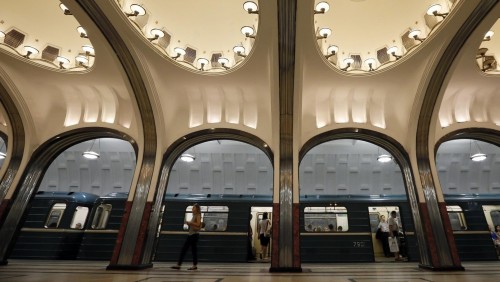The Moscow Metro is a rapid transit system serving a large part of Moscow, as well as the neighboring city of Krasnogorsk. With its first section opening in 1935, it was the first underground railway system in the former Soviet Union.
The system is situated almost entirely underground, though some lines (specifically, Sokolnicheskaya, Zamoskvoretskaya and Filyovskaya) cross the Moskva River, while Sokolnicheskaya Line also crosses the Yauza River by bridge. The system sometimes reaches a depth of more than 60 meters (200 feet) below ground. Fewer than 10% of the stations are at or above the surface level. There are 182 stations and 301.2 kilometers (187.2 miles) of route length.
Moscow Metro is the world's second most heavily used rapid transit system after the Tokyo's twin subway. It has 12 lines and on a normal weekday it carries over 7 million passengers. Passenger traffic is considerably lower on weekends, bringing the average daily passenger traffic during the year to 6.6 million passengers per day.
During the morning and evening rush hours, trains run roughly every 90 seconds on most lines. At other times during the day, they run about every two to three and a half minutes, and every six to ten minutes late at night. Given the frequency of service, specific timetables are not necessary nor provided to passengers.
The Moscow metro comprises 182 stations, out of which 73 are deep-level, and 88 are shallow. Of the deep stations, 52 are pylon-type, 18 are column-type and one is "single-vault" (Leningrad technology). The shallow stations comprise 63 of the pillar-type (a large portion of them following the infamous "sorokonozhka" design), 20 "single-vaults" (Kharkov technology) and three single-decked. In addition there are 11 ground-level stations and four above ground. Two of the stations exist as double halls, and two have three tracks. Five of the stations have side platforms (only one of them-subterranean). The station Vorobyovy Gory is on a bridge. Three other metro bridges exist but are covered or hidden. In addition, there are two closed stations and one that is derelict. There are also four stations reserved for future service.
The Arbat is one of the oldest surviving streets in Moscow. In the year 1493 the whole city was engulfed in a terrible fire caused by a candle in the Church of St. Nicholas in Peski which is situated on Arbat. However, the first mention does not clarify the origin of the street name. According to one of the versions the word Arbat derives from the Arabic word "arbad" meaning "suburb". At that time the city center was within the Kremlin walls and the surrounding areas were regarded as suburbs.
Arbat district changed over the centuries. Originally populated with craftsmen and merchants it became the favorite site of aristocracy in the late 18 century. The most famous noble families settled here. One of such noble mansions was rented by Alexander Pushkin after his marriage to Natalie. The Moscow high life was beyond his means. This couple had to move into the countryside leaving behind spectacular balls and luxurious assemblies.



